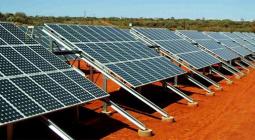Renewable hybrid energy systems as a game changer.
These can generate round-the-clock power with cost and reliability levels comparable to coal-fired plants.
India recently conducted two auctions for wind/solar hybrid projects. Both the auctions were under-subscribed, with bids totalling 1.56GW awarded to SB Energy, Adani Green Energy and ReNew Power, against a total of 2.4GW on offer. The discovered prices were marginally below the ceiling tariff of₹2.70. Although the initial response from industry appears guarded, we believe that renewable hybrids can play a key role in helping India accelerate the decarbonization of power generation and lowering the cost of electricity in the medium term.
India has added 65-70GW of wind and solar capacity so far, with wind and solar contributing 9.5% of generated energy in May 2019. If the government target of 175GW is achieved by 2022, this share could exceed 15-16%. Renewable energy has three inherent challenges. First, it relies on intermittent sources, producing energy only when the sun is shining or wind is blowing; second, its output is constrained to specific hours of the day; third, its use leads to lower utilization of transmission lines. This can create issues in matching peak power demand with renewable output (e.g. in evening hours when solar energy is not available), and raise costs of transmission. Experience in countries which have achieved renewable energy penetration of over 15% indicates that some flexible energy resources which can rapidly ramp up or down are needed. These could include hydro or gas-based power, or energy storage solutions.
Renewable hybrids can be one solution to the above issues. Simply put, a hybrid system can combine wind, solar with an additional resource of generation or storage. Let us take an example: in India, we observe that solar output is maximum between 11am and 3pm, while wind output is highest in late evening and early morning. Peak demand for power is reached in the evening hours of 6-9pm, which cannot be catered to by either wind or solar. If we can store some energy during excess renewable generation hours and release it into the grid during peak demand hours, the combined “hybrid" system can produce 24x7 clean energy in response to varying levels of demand through the day. The storage can take many forms, such as batteries, pumped hydro or mechanical storage through flywheels. The intermittency of wind and solar could also be balanced by adding a fast ramping source of power; for example, an open cycle gas turbine. The overall output of the hybrid system can thus be matched against a required load on an hourly basis. In this way, it can provide both baseload and flexible power.
Hybrid systems are expected to become increasingly cost competitive, driven by reducing costs of battery storage and solar energy. An optimal combination of solar, wind and storage can deliver stable round-the-clock power even at today’s costs of around ₹6-7/kWh. Compared to baseload coal plants, this is significantly higher. However, lithium-ion battery costs are expected to fall from current $220-240/kWh to below $100 in next 3-4 years. Similarly, levelized costs of solar energy have plummeted from ₹4.63/kWh in 2016 to ₹2.50/kWh in the latest auctions and may fall as low as ₹2/kWh in the next 3-5 years.
McKinsey’s proprietary modelling suggests that that if the above improvements are factored in, wind-solar storage hybrid systems could generate round-the-clock power with cost as well as reliability levels comparable to existing coal-fired power plants in the next 4-5 years. For example, a hybrid system which is required to deliver a flat load of 250MW could be designed by combining solar, wind and battery storage, at a levelized cost of energy at ₹3-4/kWh by 2025. This is, of course, dependent on the specific location and some seasonal variations.
India’s ministry of new and renewable energy released a solar-wind hybrid policy in 2018. This provides a framework to promote grid-connected hybrid energy through set-ups that would use land and transmission infrastructure optimally and also manage the variability of renewable resources to some extent.
India is not the only country planning hybrid projects; 50-plus hybrid projects of MW-scale have already been announced or are under construction globally, with Australia and US being the leaders. For larger capacities or longer duration balancing, pumped hydro is a viable storage solution, but is restricted by the lack of suitable physical locations.
If the economics of hybrid systems do approach the above levels, our analysis indicates that they can potentially be competitive with 30-40% of existing coal-fired stations in India. They can therefore become a viable solution to meeting future baseload power requirements, all at zero carbon emissions and future cost-inflation proof. Several leading Indian corporates are also showing active interest in increasing their usage of clean power if round-the-clock solutions are available.
This opens up important questions for India’s future power-system planning. Should India continue to build new coal-fired plants to meet baseload requirements, or could renewable hybrids take a significant share? How should investors who are evaluating existing stressed coal-fired assets put a value on them 5-7 years ahead? Most importantly, what policy and regulatory changes need to be made so that India can fully capture the potential of this interesting disruption in the energy sector?
Suvojoy Sengupta & Ketav Mehta are, respectively, leader of McKinsey’s renewables work within the electric power and natural gas practice in India, and engagement manager in the firm’s Mumbai office.
19 August 2019
livemint




